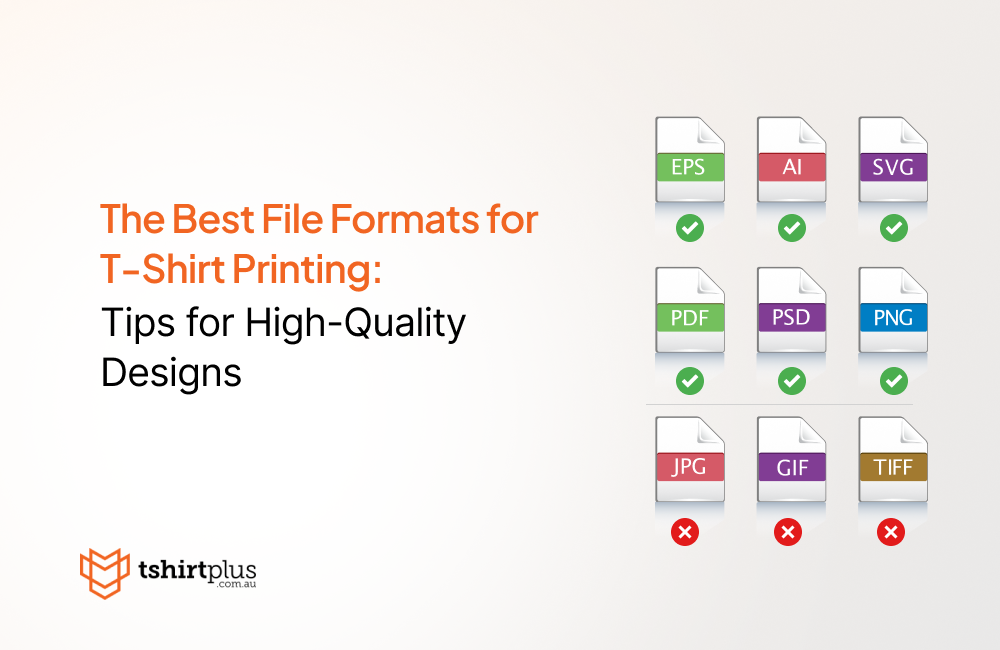
PNG vs JPEG – Which image format is better for t-shirt printing?
JPEG is suitable for simple designs and quick printing needs, but its lossy compression and lower resolution make it less reliable for professional-quality prints.
PNG, on the other hand, is ideal for detailed designs, graphics, and transparent elements but lacks CMYK support, which limits its use for high-end t-shirt printing.
- Use JPEG for basic designs or when file size is a priority.
- Use PNG for detailed graphics, vibrant colours, and designs requiring transparency.
Both formats have their pros and cons, so the choice ultimately depends on the design requirements and printing process. To help you out, here is more explanation about these file types:
What Is JPEG (or JPG)?
JPEG (Joint Photographic Experts Group) is a widely used image format known for its compressed size and good image quality. Most images shared online and on devices like smartphones and digital cameras are saved in JPEG format because it balance file size and visual fidelity. This makes it ideal for saving storage space while maintaining decent image quality.
JPEG is particularly popular on social media and for web use because it provides vibrant colours and a pleasing tone. While it’s often used for printing photos and archiving images, its lossy compression can affect quality in some cases.
Key Benefits of JPEG
Small File Size: Saves storage space on phones and drives.
Wide Compatibility: Works across most devices, media platforms, and editing tools.
Fast Downloads: Quick to upload and share online.
Ready for Use: Requires minimal editing for colour balance, contrast, or sharpening.
When to Use JPEG
For social media and online content, where vibrant colours and small file sizes are preferred.
For printing fine art or photos, especially when using high-resolution raw JPEG files.
To share edited files with clients quickly, as they take up less space.
Is JPEG Good for T-Shirt Printing?
JPEG files can work for t-shirt printing, but they’re not the best choice. While they are easy to use and widely supported, their lossy compression means data is lost when editing, leading to reduced resolution and quality. This becomes a problem when printing high-detail designs like text, graphics, or geometrical drawings, as these elements need sharpness and clarity.
JPEG files are better suited for simple designs with strong colour tones but may not deliver the precision and quality required for professional t-shirt printing.
What Is PNG?
PNG (Portable Network Graphics) is a format known for maintaining image quality and resolution, even after editing. Unlike JPEG, PNG files do not lose any data during editing, making them the preferred choice for professionals working with designs that require precision.
One of PNG’s standout features is transparency, which allows designers to create images with transparent backgrounds or overlays. This is especially useful for layering designs and creating effects such as shadows or highlights. PNG files are ideal for images with text, graphics, maps, or geometric elements where clarity is critical.
Key Benefits of PNG
High Resolution: Retains quality after editing.
Perfect for Graphics: Works well with text, geometric designs, and detailed illustrations.
Transparent Backgrounds: Enables overlaying images without a background.
Vivid Colors: Maintains vibrant and sharp colour tones.
When to Use PNG
For designs that require transparency or overlays.
When working with text, graphics, or geometric elements that demand high precision.
For creating vibrant and detailed images, especially for professional design work.
Is PNG Good for T-Shirt Printing?
PNG is often preferred for t-shirt printing because of its high resolution and ability to retain detail, even after editing. However, there is one significant limitation:
- PNG does not support CMYK (cyan, magenta, yellow, black) colour profiles, which are essential for professional printing processes. Instead, PNG files use RGB (red, green, blue) profiles, which can cause colour discrepancies when printed.
Despite this, PNG files are great for vibrant designs, especially when used in design software that recommends exporting in PNG. The file size, though larger, ensures sharpness and clarity, making it an excellent choice for complex designs.
What is the best DPI for T-Shirt Printing?
The best DPI (Dots Per Inch) for t-shirt printing is typically 300 DPI. This resolution ensures that the design is sharp, detailed, and of high quality when printed on fabric. Lower resolutions, such as 72 DPI, may appear pixelated or blurry, especially on larger prints, while higher resolutions like 300 DPI provide the clarity needed for professional results.
Using a 300 DPI file is especially crucial for printing methods like Direct to Garment (DTG), Screen Printing, and Dye Sublimation, where fine details and vibrant colours matter. For large-scale designs, ensure the artwork is created at the final print size of 300 DPI to maintain quality. Always check with your printer for specific DPI requirements based on the printing method and fabric type.
Is SVG a Good File Format for T-shirt Printing?
SVG (Scalable Vector Graphics) is a suitable file format for t-shirt printing, especially for vector-based designs like logos, text, and geometric patterns. Its resolution-independent nature ensures the design remains sharp and crisp regardless of size, making it ideal for large-scale prints or intricate details.
SVG files are also lightweight, easy to edit, and compatible with most modern design software, allowing designers to create precise artwork with ease. However, SVG files aren’t directly used by many printing machines, as these devices often require raster formats like PNG or TIFF for processing.
To use SVG effectively for t-shirt printing, the file must often be converted to a printer-friendly format while maintaining the original quality. SVG is particularly advantageous during the design phase or when transferring files between designers and clients because it retains clarity and can be easily adjusted.
While it’s not always the final format sent to the printer, SVG serves as an excellent starting point for creating scalable and high-quality designs for professional t-shirt printing. Always check with your printer to confirm compatibility and file requirements.
SVG vs PNG – Which File Format is Better for T-Shirt Printing?
When it comes to t-shirt printing, SVG (Scalable Vector Graphics) and PNG (Portable Network Graphics) serve different purposes, making one better than the other depending on your design needs.
SVG files are ideal for vector-based designs like logos, text, or geometric patterns because they are resolution-independent, meaning they can be scaled to any size without losing quality. This makes SVG perfect for designs requiring sharp edges and precision. However, SVG files are not directly compatible with all printing methods, as many t-shirt printers require raster formats like PNG or JPEG for processing.
PNG, on the other hand, is a raster format that retains high resolution and supports vibrant colours, making it great for detailed images and designs requiring transparency, such as overlays or intricate graphics.
Unlike SVG, PNG files are widely supported by printing equipment but may lose quality when scaled to larger sizes. For the best results, use SVG for creating and exporting vector designs and convert them to high-resolution PNG if your printer requires a raster format for production.
SVG vs EPS – Which File Type is Better for T-Shirt Printing?
When choosing between SVG (Scalable Vector Graphics) and EPS (Encapsulated PostScript) for t-shirt printing, the decision depends on your design and printing method.
SVG is a modern vector format that allows for scalable designs without losing quality, making it ideal for logos, text, or geometric graphics. SVG is widely compatible with design software and web platforms but may not be supported by all professional printing machines, especially older setups.
EPS, on the other hand, is a more established vector format specifically designed for professional printing. It supports advanced colour settings, including CMYK profiles, which are crucial for high-quality t-shirt printing.
EPS files are better suited for detailed and colour-accurate designs when working with commercial printers. While SVG is great for design flexibility and digital use, EPS is often the preferred format for professional t-shirt printing due to its compatibility with most print workflows and its ability to retain sharpness and colour accuracy.
Which Type of Files Are Best for Different Printing Methods?
The best file types for printing depend on the decoration methods. Here is a breakdown of the file formats as per the printing methods:
- Direct to Garment (DTG) Printing: PNG and TIFF with high resolution (300 DPI) and transparent backgrounds work best for detailed and colourful designs.
- Vinyl Heat Transfers: SVG or EPS files are ideal for creating vector-based designs with sharp edges and precise cuts.
- Screen Printing: EPS or AI files with vector graphics ensure crisp, scalable designs suitable for layering colours.
- Dye Sublimation: JPEG or PNG in high resolution (300 DPI) works well, as this method relies on vibrant, full-colour designs.
- Laser Transfers: JPEG or PDF with high resolution is recommended for crisp details in multi-colour or photographic designs.
- Digital Full Colour Transfer: PNG or TIFF files with a transparent background are ideal for retaining vibrant colours and detail.
- Direct to Film (DTF) Printing: PNG files with high resolution and transparency are perfect for achieving vibrant, detailed designs.
- Embroidery: DST or PES files, which are machine-readable embroidery file formats, are essential for translating designs into stitch patterns. AI or EPS files can be used for vector designs before conversion to embroidery formats.




